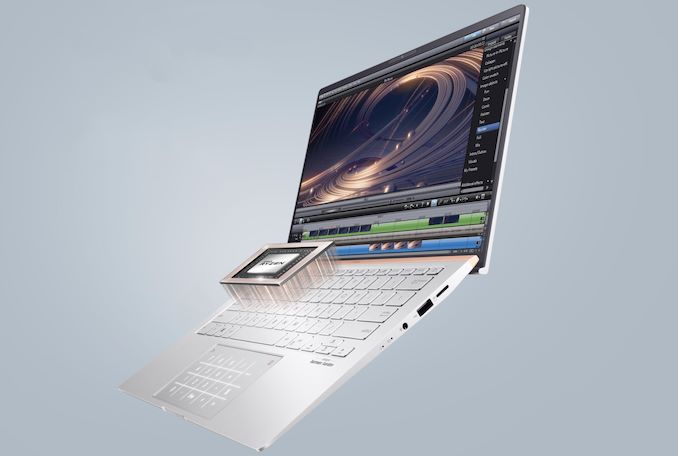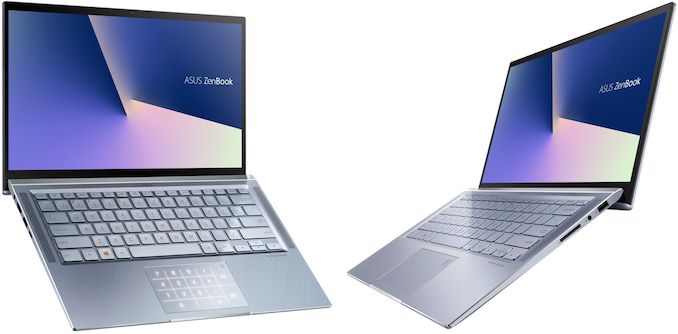ASUS Launches AMD Ryzen-Based ZenBooks: Two Laptops & a Convertible
by Anton Shilov on August 22, 2019 9:00 AM EST- Posted in
- Notebooks
- Asus
- Laptops
- Zenbook
- Ryzen Mobile

ASUS has quietly added three ZenBooks based on AMD’s Ryzen Mobile 3000-series APUs to its lineup. One of the machines is a convertible ZenBook Flip 14, the other two are traditional ZenBook 14 notebooks. All three mobile PCs offer what you come to expect from ZenBook-branded laptops: stylish design, sleek aluminum chassis, high performance components, robust connectivity, and various premium features like Harman Kardon-badged audio or a NumberPad touchpad.
The lineup of ASUS ZenBook notebooks powered by AMD’s 15 Watt Ryzen 7 3700U Mobile or Ryzen 5 3500U Mobile with integrated Radeon Vega graphics currently includes three models: the relatively basic ZenBook 14 UM431DA, the more premium ZenBook 14 UM433DA, and the convertible ZenBook Flip 14 UX462DA.
All the ASUS ZenBook systems based on AMD’s Ryzen Mobile APUs feature a 14-inch InfinityEdge Full-HD display with or without touch support that cover 100% of the sRGB color gamut. While all of the mobile PCs feature thin bezels, the UM433DA seems to feature the thinnest bezels, whereas the UM431DA has the thickest. Meanwhile, the ZenBook Flip 14 UX462DA naturally supports touch, can work with the ASUS Pen (1024 pressure levels, 10-300 grams pen-tip force, Windows Ink, etc.), and features the company’s 360-degree ErgoLift hinge
When it comes to internals of the ZenBook 14 UM431DA, ZenBook 14 UM433DA, and ZenBook Flip 14 UX462DA, they are all powered by AMD’s quad-core Ryzen Mobile 3000-series APUs with integrated Radeon Vega graphics that are paired with 8 to 16 GB of DDR4-2400 memory as well as an SSD ranging from 256 GB to 1 TB (see exact specs in the table below). In a curious move (perhaps for cost-cutting reasons) ASUS decided to use SATA or PCIe 3.0 x2 SSDs on most SKUs; only the most expensive 1 TB SSD features a full PCIe 3.0 x4 interface.
From connectivity standpoint, we have a fairly standard machines with 802.11ac Wi-Fi, Bluetooth, USB Type-A and USB Type-C connectors, an HDMI display output, and a 3.5-mm audio jack. Meanwhile, only the model UM433DA supports USB 3.1 Gen 2 despite the fact that AMD’s mobile platform fully supports the technology.
As far as battery life is concerned, the ZenBook 14 UM431DA and the ZenBook 14 UM433DA are equipped with 47 Wh and 50 Wh batteries rated for up to 12 hours of work on one charge. By contrast, the convertible ZenBook Flip 14 UX462DA comes with a 42 Wh battery rated for 9 hours.
| Specifications of the ASUS ZenBook PCs Based on AMD's Ryzen APUs | ||||
| ZenBook 14 UM431DA |
ZenBook 14 UM433DA |
ZenBook Flip 14 UX462DA |
||
| LCD | Diagonal | 14" NanoEdge | ||
| Resolution | 1920×1080 | |||
| Anti-glare | Yes | ? | ? | |
| Bezels | 6.45-mm bezels | 2.9-mm side bezels 3.3-mm bottom bezel |
4.3-mm bezels | |
| Color Gamut | 100% sRGB | |||
| Touch Support | No | Yes ASUS Pen supported |
||
| Protective Glass | ? | ? | ? | |
| CPU | AMD Ryzen 7 3700U - 4C/8T, 6MB, 2.3/4 GHz - Radeon RX Vega 10 AMD Ryzen 5 3500U - 4C/8T, 6MB, 2.1/3.7 GHz - Radeon Vega 8 |
|||
| Graphics | Radeon RX Vega 10 Radeon Vega 8 |
|||
| RAM (maximum) | 8 or 16 GB DDR4-2400 | 8 or 16 GB DDR4-2400 soldered down |
8, 12, or 16 GB DDR4-2400 soldered down |
|
| Storage | SSD | 256 GB PCIe 3.0 x2 512 GB PCIe 3.0 x2 1 TB PCIe 3.0 x4 |
256 GB SATA 256 GB PCIe 3.0 x2 512 GB PCIe 3.0 x2 |
|
| Card Reader | SD card reader | MicroSD card reader | ||
| Wireless | Wi-Fi | 802.11ac | ||
| Bluetooth | BT 5.0 | BT 4.2 | ||
| USB | 3.1 Gen 2 | - | 1 × Type-A 1 × Type-C |
- |
| 3.0 | 1 × Type-A 1 × Type-C |
- | 1 × Type-A 1 × Type-C |
|
| 2.0 | 1 × Type-A | |||
| Display Output | 1 × HDMI | |||
| Camera | 720p | 720p + IR camera for face authentication | ||
| Fingerprint Sensor | Optional | ? | ? | |
| Other I/O | Microphone, stereo speakers, audio jack | |||
| Other Sensors | ? | ? | Accelerometer, gyroscope, etc. | |
| Battery | 47 Wh 12 hours |
50 Wh 12 hours |
42 Wh 9 hours |
|
| Dimensions | Width | 34.2 cm | 12.7 inches | 31.9 cm | 12.6 inches | 32.2 cm | 12.37 inches |
| Depth | 21.2 cm | 8.34 inches | 20.5 cm | 8.07 inches | 21 cm | 8.27 inches | |
| Thickness | 1.59 cm | 0.62 inches | 1.58 cm | 0.62 inches | 1.89 cm | 0.74 inches | |
| Weight | 1.39 kilograms 3.06 pounds |
1.25 kilograms 2.76 pounds |
1.6 kilograms 3.53 pounds |
|
| Launch Price | ? | ? | ? | |
Wrapping things up, the ZenBook Flip 14 with AMD's processors is available in many countries in different configurations and at various price points. Meanwhile, the ZenBook 14 UM431DA and the ZenBook 14 UM433DA notebooks will be available shortly, with prices to be determined.
Related Reading:
- ASUS Unveils ZenBook Edition 30 Laptop: 13.3-Inch Dual Screen with GPU
- HP Reveals Envy x360 15 Laptops with AMD's Latest Ryzen APUs
- The Lenovo ThinkPad A285 (12.5-Inch) Review: Ryzen Pro Gets Down to Business
- Lenovo Lists ThinkPad E485/E585: AMD’s Ryzen Mobile Land in Business PCs
Source: ASUS (1, 2, 3), NotebookCheck, Liliputing














31 Comments
View All Comments
GruenSein - Thursday, August 22, 2019 - link
I'd love to get an AMD-based mobile device but buying a Zen+-based machine months after Zen 2, which is not just a good competitor but actually just as fast or faster than Intel's offerings, has been released just feels wrong.sgeocla - Thursday, August 22, 2019 - link
Zen2 for now is just for desktops and servers. Those share the same CPU chipletd. It may take a while before it comes to mobile APUs such as Ryzen 3700 as they cannot use the normal Zen2 7nm dies and the IO dies that are actually 14nm.sing_electric - Thursday, August 22, 2019 - link
Doesn't make OP wrong - if you need a new laptop TODAY, sure, a Zen+ based one might be a decent choice, and it's refreshing to see Asus releasing AMD-based laptops that don't treat the platform like it belongs in the discount bin (as in, chunky plastic enclosure, medicore LCD screen and, in some cases, single channel RAM that really hurts performance).Having said that, if you can wait just a few months, you'll likely be able to get a 10nm Intel-based laptop, and at some point after that, a Zen2-based AMD one, which should have better performance and battery life, plus integrated graphics that will likely see a decent performance bump over the current 3000-series.
sgeocla - Thursday, August 22, 2019 - link
I never said he was wrong. Everyone is free to decide if the wait is worth it or not.Also, Intel 10nm laptops are crazy expensive and not much better than Intel 14nm laptops if you normalize for RAM speed (10nm use 3733 LPDDRD4x) and power envelope (15w to 15w, 25w to 25W).
Intel just launched new 10th gen 14nm laptops because 10nm is not mean to volume production. Cost won't come down much due to poor 10nm yields (max 4 cores vs 6 cores for 14nm).
eek2121 - Friday, August 23, 2019 - link
Laptops in general are a bad buy right now IMO. Unless you web browse, watch movies, and do homework (or work at a company that issues laptops like I do.) Performance on the mobile side has been stagnant until Intel rolled out 10nm. GPU technology is at a standstill.t.s - Friday, August 23, 2019 - link
Unfortunately, Intel one price is not that steep compared with AMD now. Notebook price is not dictated by whose CPU the manufacturer use, but how much the manufacturer want to sell you.Targon - Thursday, August 22, 2019 - link
AMD could just implement a 7nm I/O die for the APUs as well and go for the CPU+GPU core design. Not sure how the size would end up, though we could potentially end up with a Zen2+7nm Vega pairing if Navi cores aren't used. They don't NEED to do a special die that combines both.Hul8 - Thursday, August 22, 2019 - link
I believe the someone (AMD?) has mentioned that chiplet design doesn't suit the low-cost parts: The CCDs for Ryzen 3rd gen are manufactured at TSMC over in Asia and the I/O dies in the US at GlobalFoundries. With the further logistics and assembly required to get the finished product, it's not worth it. That's why they intend on having a single die for the 4000 series (Zen 2) APUs.eek2121 - Friday, August 23, 2019 - link
I don't believe it's been mentioned anywhere that they are going to have a single die. Maybe a single CCD, but that's a given, because the rest of the area is going to have a GPU. If we are lucky we MAY see them shrink the IO die to 7nm now that yields are up. That would drop the power budget and allow for more room for a better GPU.HStewart - Thursday, August 22, 2019 - link
This is crazy idea, but it would be possible to mix 7nm Zen2 CPU die with 14nm GPU die using Forevos but you probably will not want that.